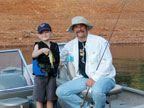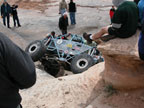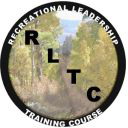|
|
|||||||||
|
|
|
||||||||||||||||||||
|
That made it easy. I’ve given my “coalition speech” dozens of times. Then it occurred to me that I should make this one of my columns. So herein I will share with you the secrets of how to build a coalition and save a recreation area. It works! This is also how to build a "Friends of" type group. Let’s start with the Assumptions:
Now we’ll look at the process for saving this recreation area. As I write this, dozens of states are doing this very thing. I have helped numerous individuals do exactly what I’m about to tell you – turn a one-person dream into a recreation-saving reality. I am essentially going to give you the formula that we used to form the world-famous Friends of the Rubicon (FOTR). Why Form a "Friends" type group? FOTR (www.rubiconfriends.com) has served as an example nationwide for coalition building and recreation-saving efforts. It does not matter what type area or access issue we’re talking about; this process is generic From the onset, I recommend your coalition be multiple-use (all interests and users). One definition of coalition is, “An alliance of factions formed for a specific purpose.” You’ll understand the reason for this better as you read through the process. STEP ONE is “Step up to the plate.” Only one person need start a recreation-saving effort. But someone does need to step up and start the ball rolling. Do not assume someone else it out there saving your play area/trail. You can take the first step and start the ball rolling. I’m a good first contact. I will help anyone save a recreation or trail/riding area. Step up to the plate and label yourself the savior of a trail or area. Start calling yourself the Trail Boss or President of your newly formed group: Friends of <My Area>. STEP TWO is to communicate -- begin collecting emails and contact information for other folks who might be interested in your area. Start an emailing list or network. Get the word out to other activists that you are in the beginning stages of starting a Friends group. I'm a good first stop. Take a multiple-use approach. Get in touch with all forms of users (equestrians, snowmobilers, ATVers, wheelers, rock collectors, sheep herders, hunters, etc.) who might be using your area. Align your group with other groups of similar interest. (Read Del's article on Can Multiple-Users Rule the World?) By aligning with other groups right off the bat, you can save yourself tons of work and wheel-reinventing. Besides, we must be unified in our efforts and find ways to reduce user conflict before we ever get in front of an elected official or government agent. I can help you start a statewide or regional emailing list. Eventually you may want to find a list-serve ISP or provider that will host your email list so you can make it a subscribe-only, moderated list. Bulletin Boards and Forums seem to be the popular way to go these days, but even if you have to start a blog or Facebook account, just get the word out that a new group is forming to help save a recreation area. No matter how you do it, get hooked up with everyone and anyone that might be an ally for your recreation area. It is usually critical though, that you take a multiple-use approach to saving your riding area. We cannot have user disagreements and conflict arise when it comes time for public testimony or grant money applications. Eliminate these possibilities early on by having all users working together. STEP THREE is to advertise. PICK A NAME; Buy a Domain Name! Get it done right away. Make is simple. Try not to have a www.withyourentirefriendsnamespelledout.com web site, unless it is a link to a much shorter name. It's too hard to type and remember in most cases. Keep it simple and short. Use .org if you can buy it, showing that you are an organization. Get a web site going. Through your email network (or meetings if you have the luxury), build a Mission or Purpose Statement. Promote this. Send out flyers to local merchants. Send letters to local elected officials introducing your group and your interest. Build your membership; and build it quick so you can start making a difference. Conduct field trips and ride-along's. Get your county commissioner or Board of Supervisors out on the ground with you. Write a press release to your local papers and write letters to the editors. Let the world know that Friends of <My Area> exists and they’d best deal with you when it comes to talking about that area. STEP FOUR is organizational development. Build your membership through word of mouth and emailing networks. Have at least one official meeting a year; the rest of your business might easily be handled by email and field trips. Set up an informal chain of command so you have folks you can delegate tasks and projects. Encourage volunteers to take the reins and run a clean up or trail maintenance project. Consider getting key folks and leaders some training on how to be a better volunteer leader. I offer the Recreational Leadership Training Course (RLTC) as one example. Decide on whether you want to incorporate or have a separate group be your officialdom incorporation. John Stewart, Cal4, has a lot about incorporating right here. Advertise everything you do. Find a volunteer who writes, and ask them to do a few articles about your new coalition and the work you are doing. Take a member of the local press out with you and let them write the story (as long as they are friendly to your cause). No matter how many meetings you do or don’t have, run your meetings well. Too many meetings, or poorly run meetings can kill a coalition quickly. Visit my web site for a guaranteed winner way to run a meeting (www.delalbright.com/Articles/meetings.htm) I am not suggesting that you need to get very official. In fact, I am suggesting you try to keep things simple. FOTR has no dues; no structure; no officers or Board of Directors, and it works just fine. Donations come in when needed, and are mostly project related. However, each case is different. It would depend on the area politics and interests of the group. Get a Club Start Up Kit from NOHVCC (free) right here. Get an Activists Tool Kit from BlueRibbon Coalition During this step, you can get somewhat official and set up things like an Oversight Committee for <My Area>. We have one for the Rubicon Trail called the Rubicon Oversight Committee (ROC). It’s composed of user groups, private landowners, commercial trail users, local, state and federal agencies, as well as environmental groups. Obviously, not all these folks would be members of your Friends of <My Area>. Oversight Committees usually guide the future development (or lack thereof) of a riding area. It’s important to have all interested parties represented, as this will help you eliminate roadblocks before you get up against them. During this step you should also start pursuing grant money for your recreation area, in cooperation with the new partners you’ve developed. The Recreational Trails Program (RTP) is the first place to look. $50,000,000 is available nationwide. Visit my web site for more on RTP (www.delalbright.com/RTP/rtp_enter.htm). CA has a great OHV program with grant money available through State Parks. Other states have similar programs to supplement the RTP idea. If you’d like to get more official, you can get help from publications available from various organizations like the American Motorcycle Association (www.ama-cycle.org), the National OHV Conservation Council (www.nohvcc.org) or your state/regional organizations. You can also look into incorporating (501.c.3, 4, 6, 7 etc.) under IRS rules. Check out MuirNet. STEP FIVE is to stay alive as a group. This is the ongoing process of keeping folks informed; letting your members of Friends of <My Area> vote on issues and become project leaders so they have ownership in the area. Make your coalition an inclusive effort wherein everyone has a say, yet you still have designated leaders/teams to make the final decisions and get actions going. Schedule at least one annual cleanup/workday to keep folks interested in preserving the riding area. Plan fun events in your riding area, such as picnics, informal meetings, rides, and family outings. Conduct raffles if your group likes them. Keep your group alive. Let businesses know about you. Ask them to help feed the troops or provide some support for your work. This article gives you the foundation to start a coalition and begin saving your riding area. The formula works. I will help you through this process, step by step if you’d like. Feel free to contact me. (Example “Friends” type groups: www.rubiconfriends.com, Friends of the Rubicon (FOTR) www.sandmountain-nv.org, Friends of Sand Mountain; www.friendsofhighlakes.com, Friends of High Lakes www.oceanodunes.org, Friends of Oceano Dunes - now Pismo). |











